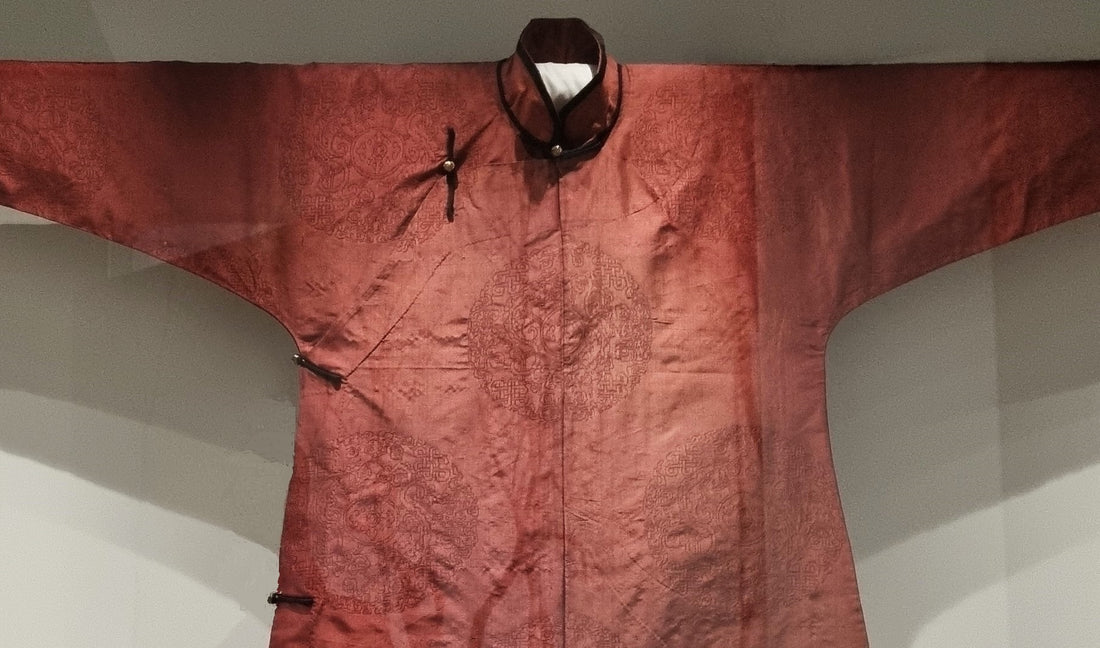
LOST TRADITIONS IN CHINESE DRESS
Text by Helen (Siuyi) Ting
An almost forgotten tradition in Chinese fashion, Belt toggles, known as zhuizi (坠子), are small carved ornaments used as counterweights on cords tied around belts in traditional Chinese dress.
Traditional Chinese garments up until the 1940s did not have pockets. Instead both men and women had external pouches for small items such as money, tobacco, perfume or even chopsticks.
Toggles gradually disappeared in the early 1900s as Western styles of dress became more fashionable across China. Zhuizi are decorative and functional objects that also embody great symbolic and cultural significance. Carved from a diverse range of natural materials to represent a variety of figures, plants, animals, and everyday objects, these splendid miniatures manifest Chinese culture and material values.

Image: toggle made from walnut depicting a frog on a lotus leaf, China. Powerhouse collection, gift of Alistair Morrison, 1992, 92/480. Image above: Men's silk robe circa 1850.
The pouches were often concealed behind tunics or coats. A toggle acted as a decorative counterweight to the pouch or embroidered bag. Threaded with a cord and suspended from the wearer's belt, the toggle helped keep the pouch in place and its contents within easy reach.
Belt toggles were often carved in the shape of traditional good luck symbols to bring healing or protective properties to the wearer. This language of good luck symbols continues into China today.

Image: Wooden toggle of girl sleeping on a leaf.
Currently on display at the Chau Chuk Wing Museum in Sydney Australia are a selection of toggles shown side by side with Qing Dynasty silk robes, silk belt accessories and drawings demonstrating how traditional Chinese fashion incorporated these miniature carvings. The toggles are from the collection of Alistair and Hedda Morrison who acquired them in antique markets in Peking in the 1940s. Items on which the carvings were based such as embroidered shoes and wicker baskets also feature.
Also displayed are some of Hedda's photos from the 1930-40s. A studio photographer in Peking, in her spare time Hedda photographed everyday and often humble street life. China had undergone huge change with the end of the last imperial dynasty, the Qing Dynasty, in 1912. The republic era was to last only until 1949 with the beginning of the People's Republic of China. The robes, jackets and toggles worn in the 1930s and 40s, a reminder of China's imperial era, were starting to disappear from use.

Image: Embroidered shoes from 19th Century shown next to wooden toggle symbolising harmony in married life (the Chinese word for shoes sounds like harmony).
These objects shine a light on life when traditional Chinese dress was common and people still wore belt toggles.
Chinese Toggles: Culture in Miniature is on show at the Chau Chuk Wing Museum until April 2024.
Find out more:
www.sydney.edu.au/museum
An almost forgotten tradition in Chinese fashion, Belt toggles, known as zhuizi (坠子), are small carved ornaments used as counterweights on cords tied around belts in traditional Chinese dress.
Traditional Chinese garments up until the 1940s did not have pockets. Instead both men and women had external pouches for small items such as money, tobacco, perfume or even chopsticks.
Toggles gradually disappeared in the early 1900s as Western styles of dress became more fashionable across China. Zhuizi are decorative and functional objects that also embody great symbolic and cultural significance. Carved from a diverse range of natural materials to represent a variety of figures, plants, animals, and everyday objects, these splendid miniatures manifest Chinese culture and material values.

Image: toggle made from walnut depicting a frog on a lotus leaf, China. Powerhouse collection, gift of Alistair Morrison, 1992, 92/480. Image above: Men's silk robe circa 1850.
The pouches were often concealed behind tunics or coats. A toggle acted as a decorative counterweight to the pouch or embroidered bag. Threaded with a cord and suspended from the wearer's belt, the toggle helped keep the pouch in place and its contents within easy reach.
Belt toggles were often carved in the shape of traditional good luck symbols to bring healing or protective properties to the wearer. This language of good luck symbols continues into China today.

Image: Wooden toggle of girl sleeping on a leaf.
Currently on display at the Chau Chuk Wing Museum in Sydney Australia are a selection of toggles shown side by side with Qing Dynasty silk robes, silk belt accessories and drawings demonstrating how traditional Chinese fashion incorporated these miniature carvings. The toggles are from the collection of Alistair and Hedda Morrison who acquired them in antique markets in Peking in the 1940s. Items on which the carvings were based such as embroidered shoes and wicker baskets also feature.
Also displayed are some of Hedda's photos from the 1930-40s. A studio photographer in Peking, in her spare time Hedda photographed everyday and often humble street life. China had undergone huge change with the end of the last imperial dynasty, the Qing Dynasty, in 1912. The republic era was to last only until 1949 with the beginning of the People's Republic of China. The robes, jackets and toggles worn in the 1930s and 40s, a reminder of China's imperial era, were starting to disappear from use.

Image: Embroidered shoes from 19th Century shown next to wooden toggle symbolising harmony in married life (the Chinese word for shoes sounds like harmony).
These objects shine a light on life when traditional Chinese dress was common and people still wore belt toggles.
Chinese Toggles: Culture in Miniature is on show at the Chau Chuk Wing Museum until April 2024.
Find out more:
www.sydney.edu.au/museum
